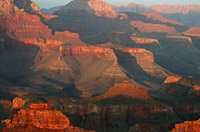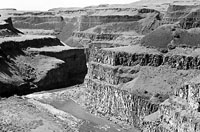
"Time is what stops everything happening all at once"*
| ESS 461 home |
| Information |
| Lecture notes |
| Labs |
| Research project |
| Term papers |
| Reading |
| Web resources |
| Footnotes |
| FAQ |



Introduction
Welcome to ESS 461. This is the class where you find out how old the Earth is, and how we know how old the Earth is.Most of the class is devoted to radiometric dating methods, so we begin with a quick look at nuclear structure and stability, the chart of the nuclides and the various forms of radioactivity.
From there we move on to ...
(Simple) mathematical description of radioactive decay and daughter isotope growth. Requirements for an accurate geochronometer. Basic assumptions underlying all radiometric dating methods. Simple parent-daughter systems. Systems involving a continuously produced parent isotope or a disappearing daughter isotope.
Chemical and isotopic measurements - Chemical analyses. Decay counting methods. Mass spectrometry. Atom counting methods. Isotope dilution. Errors, accuracy and precision. Isotopic decay methods - Radiocarbon dating and applications to archeology. Use of tritium, chlorine-36, iodine-129 (and caffeine) to date and trace groundwater. Radioactive parent - stable daughter systems. Workhorse methods of geochronology: K-Ar and 40Ar/39Ar dating, 87Rb-87Sr, 147Sm-143Nd, U-Th-Pb-He methods. Fission-tracks - geochronology by microscope. The timescale for human evolution. Dating magnetic reversals to measure rates of continental drift. Earth's oldest rocks. Earth's oldest minerals. Age of the Earth, meteorites and the solar system. Radioactive decay chains. Uranium-series methods. Dating carbonates. Isotopic disequilibrium in volcanic rocks. Radon in your basement. Measuring deposition rates with Pb-210. Trapped charge methods - Thermoluminescence, optically-stimulated luminescence, electron spin resonance. "Geomorphic" dating - Cosmic ray exposure dating. Erosion rate measurements. Cosmogenic nuclide and luminescence methods for burial dating. Thermochronlogy - Temperature-sensitive systems (leaky geochronometers). Radiation damage, He and Ar diffusion, fission tracks and track annealing. Time-temperature histories. Uplift, erosion and geothermal evolution of mountain belts. Chemical kinetic methods - Amino acid racemisation, weathering rinds, obsidian hydration. Optical isomers, chirality, and racemisation. Kinetics. Paleotemperatures from amino acid data. Layer counting and correlation methods - Ice core chronologies from oxygen and hydrogen isotope records. Dendrochronology, varve counting, stratigraphic and geochemical "pattern matching". High-resolution Quaternary climate history, Milankovitch theory, orbital periods and "tuned" chronologies. Instructor
Prof John Stone Office: 345 Johnson Hall Phone: 221-6332 stn ..at.. uw.edu
Prerequisites
As it stands, there are none. Geochronology is commonly taught with a blizzard of math and physics, which may be essential for practitioners, but tends to obscure the underlying simple concepts. Wherever possible we'll use analogies and graphical explanations; I'll be happy to develop the full mathematics with anyone who's interested. If you want to brush up on the relevant math, try: The Manga Guide to Calculus.Usually a few members of the class have taken Geochemistry which covers radioisotopes and elementary geochronology, and/or a lot of prepatory math and physics. I'm sure they'll be glad to help with study and lab questions. Class Timetable
Lecture 1:30 - 2:20 Monday, Wednesday 026 Johnson Hall Labs and lab visits 1:30 - 2:20 Friday 026 Johnson Hall unless otherwise arranged When required, computer-based lab sessions will meet in 021 or 366 Johnson Hall.
Textbooks
There are quite a few good textbooks on geochronology, but they're far too expensive for required reading. Here are some suggestions - there are more on the reading page. The two listed below are available for 3-day loan from the Course Reserves office at Odegaard library. If you're seriously interested, cheaper second-hand copies are easy to find on the web.
A good solid textbook, written specifically for our purposes, is: Faure, G. and Mensing, T., Isotopes: Principles and Applications This is the third edition of Faure's original Principles of Isotope Geology. I've arranged for a copy of each to be kept on reserve at Odegaard.
Another book I particularly like is: Dalrymple, G. Brent; The Age of the Earth. As the title suggests this one focuses on the age of the solar system, meteorites, and the ancient history of the Earth. Hence it deals mainly with long-lived isotopic dating systems (K-Ar/Ar-Ar, U-Pb, Sm-Nd and Rb-Sr). Thorough, well written and strongly recommended, but you'll want to read more widely on short-lived isotopic methods, thermochronology, Quaternary dating techniques, and so forth.
Syllabus and lab schedule
The lecture schedule will loosely follow the list of topics shown above.
Lab topics, schedule and due-dates are listed on the lab materials download page.
Grading policyMost weeks there will be labs and homework. Do a conscientious job, get them in on time, and there's a good chance you'll pass the class. The rest of your grade will be based on a term paper. I'll be looking for careful research, analysis and evidence that you've ventured beyond the prescribed reading to address the topic. Real science requires more than dipping into Google and Wikipedia.
Labs and homework 60% of your final grade Due dates on the lab schedule Term paper 40% of your final grade Due late in the quarter - TBA
